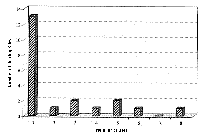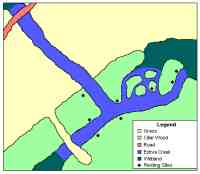 |
Last Update:
Thursday November 22, 2018
|
| [Home] |
|
Volume 17 Pages 1 - 58 (April 2000) Citation: Waldemarin, H.F. & Colares E.P. (2000) Utilisation of Resting Sites and Dens by the Neotropical River Otter (Lutra longicaudis) in the South of Rio Grande do Sul State, Southern Brazil IUCN Otter Spec. Group Bull. 17 (1): 14 - 19 Utilisation of Resting Sites and Dens by the Neotropical River Otter (Lutra longicaudis) in the South of Rio Grande do Sul State, Southern Brazil Helen Francine Waldemarin and Elton Pinto Colares Laboratório de Zoofisiologia, Departamento de Ciências Fisiológicas, Fundação Universidade do Rio Grande, Caixa Postal 474, CEP 96200-970, Rio Grande, RS, Brazil received 12th December 1999, accepted 28 January, 2000
INTRODUCTION The Neotropical River Otter (Lutra longicaudis Offers 1818) occurs from Mexico to the north of Argentina and is present over the whole of the Brazilian territory. It can be found in lakes, rivers, wetlands, marine shores associated with coastal lagoons, as well as a great variety of habitats associated with water bodies, such as forests and ciliar woods (BLACHER, 1987; EMMONS, 1990; MASON, 1990; ROSAS et al., 1991). Despite all the adaptations that they exhibit to the aquatic environment otters are still largely connected to the terrestrial environment, being dependent on it for some activities such as rest, raising of young, etc. In areas that do not have great perturbations caused by human activities they are not too critical in their choice of resting sites and can use areas on the ground without any protection (MILES, 1984). In areas where disturbance is moderate they start to use protected areas, such as burrows under the ground, rocks, trees and other objects (CHANIN, 1985). Even when they are not too critical in their choice of resting sites, places used to raise their young must be protected from the weather and other risks, and therefore they usually utilise dens (CHANIN, 1985). The aim of this study was to analyse the characteristics of resting sites and dens used by the neotropical river otter in the area studied, as well as verifying the frequency of their use throughout the year. STUDY AREA, MATERIAL AND METHODS
The Creek is a body of water, approximately one and a half kilometers long, which originates and terminates in wetlands. Its width varies between 1 and 5 meters and the depth varies from 1 to 4 meters. It is characterised by meanders and exhibits low hydro-dynamics, except during times of high pluviosity. The margins are characterised by banks of approximately 0.5 meters high, covered by grass or ciliar woods. Great amounts of floating vegetation are found in the water body itself. Between March 1997 and February 1998, the banks of the Estiva Creek were walked on eight occasions. A single experienced researcher examined the banks for up to 4 meters inland, looking for evidence of otters (spraints, footprints, resting sites and dens). Resting sites were considered as places used above the ground, whilst dens were those sites found underground. Resting sites and dens found on each of the field trips were mapped and classified as either in use or not. RESULTS A total of 21 resting sites were found during the study period. No sites were found that could be classified as dens. Thirteen were in use on only one occasion and the other eight were in use for at least two of the field trips. Only one site was in use during all the field trips.
Otter spraints were found at 90% of the rest sites. Only three of
these sites also displayed scraping behaviour (12% of total sites) and
footprints (16% of sites), these being resting sites which were used on
four, five, and eight occasions. At all other sites only spraints were
found. All resting sites were located within two meters of the river
bank and all were above the high water mark.
DISCUSSION Most resting sites identified in the Estiva Creek were temporary. Only seven sites were used more than twice, and could therefore be considered as 'regular use', according to the methodology of NEWMAN and GRIFFIN (1994). However, some sites appeared to be used on many occasions and resting sites in use by the species were found on every visit, indicating that the neotropical river otter was permanently utilising the area. JENKINS and BURROWS (1980) and MASON and MACDONALD (1986) found a greater number of otter signs on banks with well developed vegetation, whilst SERFASS (1984) and NEWMAN and GRIFFIN (1994) found that the presence of large conifers favored the existence of resting sites. In the present work there was a clear preference by the species for river banks covered by larger vegetation (such as trees), in detriment to those grass-lined banks. This probably occurs as the presence of vegetation gives better protection from rain, disturbance, and other animals. The area studied has very low levels of human activity, being mainly concentrated in summer when there is some fishing activity. The only activity that occurs throughout the year is the raising of cattle and sheep. Further, though there is a road close to the creek, the traffic density is low. CHANIN (1985) reports that otters can use resting sites above or below ground, according to the degree of disturbance in the area. All resting sites found in this area were located above ground, which may therefore be related to the low incidence of disturbance. Most resting sites exhibited only spraints as evidence of river otter use, footprints and claw marks being observed only at some of the sites used more often. Observations of Lutra longicaudis couples in captivity (COLARES, 1987) revealed an increase in digging, scratching, and out-of-water activities during the copulation period, however, in the present work, the presence of scratches and footprints was not concentrated in a specific time of the year, and in the same season there were sites with these marks and others only with spraints. Permanent use of the area, and the lack of signs of reproduction, led us to believe that the species uses this area for feeding and/or as a transit area to other regions used for feeding and/or reproduction. This is a very important area for the study of this species as it is one of the few water bodies that has banks, allowing studies of this nature. Future work is required aiming at the definition of how the species uses the Estiva Creek, as well as locating those areas used by the otters for reproduction, in order to allow the development of a Conservation and Management Plan for the species in the area. ACKNOWLEDGEMENTS - We would like to thank the Fundação Universidade do Rio Grande, the Fundação de Amparo a Pesquisa do Rio Grande do Sul, and the Clube de Seguros - ABRACE O TAIM, for logistical and financial support which allowed this work to take place. REFERENCES Blacher, C. (1987). Ocorrencia e
preservação de Lutra longicaudis (Mammalia - Mustelidae) no
literal de Santa Catarina. Boletim FBCN 22: 105-117. RESÚMEN: Utilization de sitios de descanso y madrigueras por la nutria neotropical (Lutra longicaudis) en el sur del estado de Rio Grande do Sul, Sur de Brasil Este trabajo fue realizado entre marzo de 1997 y febrero de 1998 con
el objetivo de verificar la frecuencia de utilización de lugares de
descanso por la nutria neotropical (Lutra longicaudis). A tal
efecto, fueron recorridas durante 8 veces, las márgenes de un arroyo
situado en el límite norte de la Estación Ecológica del Taim (RS), en
busca de sitios con marcas de utilización del mismo por parte de la
especie en estudio (huellas, arañazos, heces, etc). En la primera
salida de campo, los lugares encontrados fueron marcados y denominados
en relación con alguna caracteristica que permitiese su
reidentificación en las otras salidas. Durante el trabajo, trece sitios
de descanso no fueron reutilizados y ocho lo fueron al menos una vez.
Entre estos, só1o uno fue usado por la especie en todas las salidas.
Fueron encontradas heces de nutria en el 90 % de los sitios de descanso,
huellas de la especie en un 12 % y arañazos en un 16 %. Todos los
sitios reutilizados permanecieron fuera del agua durante todo el
transcurso del estudio y sólo uno de ellos se encontraba fuera de la
vegetación, habiendo sido construido en un barranco cubierto de pasto.
No fue observada ninguna cueva de nutria en el área durante el periodo
estudiado. En base a los resultados obtenidos se puede verificar que a
pesar de que la especie utiliza este arroyo para actividades de descanso
durante todo el año, es posible que no lo utilice para la reproducción. |
| [Copyright © 2006 - 2050 IUCN/SSC OSG] | [Home] | [Contact Us] |


